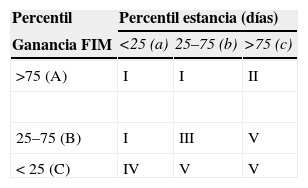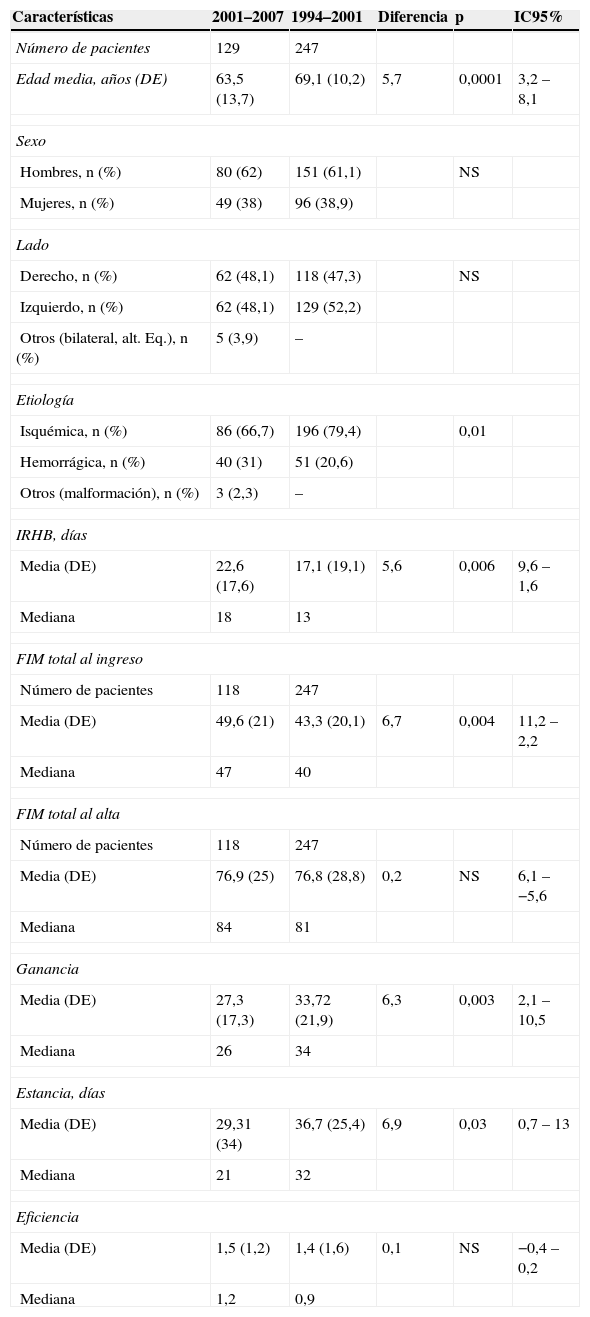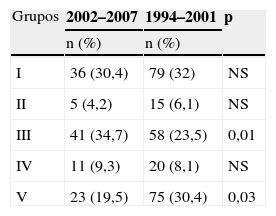El análisis de la eficiencia del tratamiento rehabilitador del accidente vascular cerebral tiene especial importancia por tratarse de una patología invalidante que requiere tratamientos prolongados y cuyo resultado depende no sólo de las características propias de la lesión sufrida, sino también de la estructura disponible, que condiciona el tipo e intensidad del tratamiento de rehabilitación.
ObjetivoSe analiza el resultado y la eficiencia del tratamiento rehabilitador del hemipléjico agudo en régimen hospitalario durante los períodos 2002–2007 (P02-07) y 1994–2001 (P94-01).
Pacientes y métodoSe realiza el estudio de una cohorte de casos consecutivos de pacientes que sufrieron un accidente vascular cerebral entre el 1-01-2002 y el 31-12-2007 e ingresaron en el servicio de rehabilitación para tratamiento.
Se mide la situación funcional por medio del Functional Independence Measure (FIM) al ingreso y al alta. La eficiencia fue considerada como el cociente entre ganancia y estancia. Se construye el patrón de resultados y la matriz de eficiencia de Stineman. Se compara la eficiencia, el patrón de resultados y la matriz de eficiencia de este período (2002–2007) con el de 1994 a 2001.
ResultadosLos pacientes del P02-07 (129 pacientes) son de menor edad que los del P94-01 (247 pacientes) (63,5 vs. 69,1; intervalo de confianza [IC] 95%: 3,2–8,1), tienen un FIM al alta similar (76,9 y 76,8), las ganancias (27,3 vs. 33,7; IC95%: 2,1–10,5) y las estancias (29,3 vs. 36,7; IC95%: 0,7–13) son inferiores, y la eficiencia es similar (1,5 y 1,4) en ambos períodos. No hay diferencias entre los patrones de resultados, aunque el percentil 75 es inferior en el P02-07 (96 vs. 103). Las matrices de eficiencia se diferencian en el grupo v (baja eficiencia), que disminuye en el P02-07 (el 19,5% vs. el 30,4%; p=0,03).
ConclusionesSe confirma la tendencia a la disminución de la estancia y la ganancia en el FIM, manteniendo la eficiencia. El grupo de baja eficiencia mejora pero, en los resultados, el percentil 75 del FIM al alta tiene valores más bajos.
The analysis of the efficiency of a stroke rehabilitation program has special importance. It requires prolonged treatments and the results depend on the kind of injury and the type and intensity of the rehabilitation treatment.
ObjectiveAnalyze the results and the efficiency of the cerebral vascular rehabilitation program in patients during these periods 2002–2007 (P02-07) and 1994–2001 (P94-01).
Patients and methodIs a study with a group of patients who suffered a cerebral vascular accident between the 01-01-2002 and the 31-12-2007 and they had admitted in the Physical Medicine and Rehabilitation service for a treatment. We used the Functional Independence Measure (FIM) before and after the rehabilitation program. The efficiency was considered like the quotient between gain and stay. It is constructed the pattern of results and the matrix of efficiency of Stineman. We compared the efficiency, the pattern of results and the matrix of efficiency of this period (2002–2007) with the one from 1994 to 2001.
ResultsThe patients of the P02-07 (129 patients) have a smaller age than those of the P94-01 (247 patients) (63,5 versus 69.1; IC95% 3,2 to 8,1), they have a similar FIM (76,9 and 76.8), but the gain (27,3 versus 33.7; IC95% 2,1 to 10,5) and the stay (29,3 versus 36.7; IC95% 0,7 to 13) are inferiors, and the efficiency is similar (1,5 and 1.4) in both periods. There are no differences between the patterns of results, although the percentile 75 is inferior in the P02-07 (96 versus 103). The matrix of efficiency are different in the group V (low efficiency) that falls in P02-07 (19, 5% versus 30, 4%; p=0.03).
ConclusionsThere is a reduction in the stay and the gain in the FIM, but the efficiency is similar. The group of low efficiency improves but, in the results, percentile 75 of the FIM at discharge has lower values.
Artículo
Comprando el artículo el PDF del mismo podrá ser descargado
Precio 19,34 €
Comprar ahora












